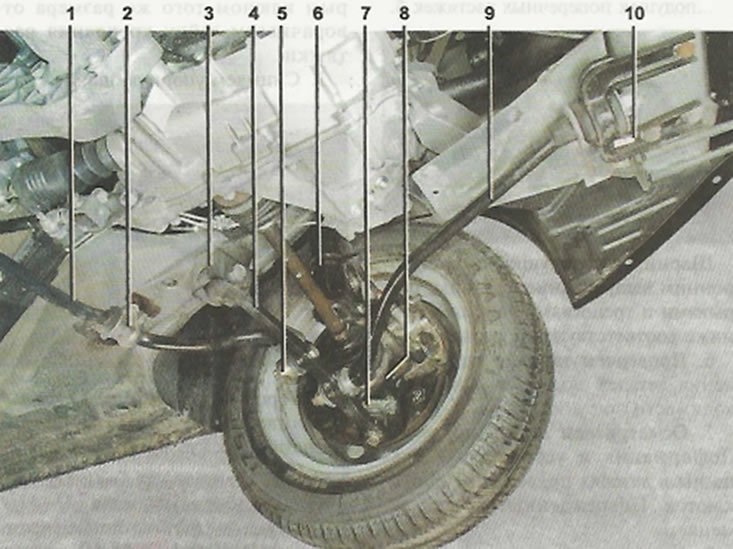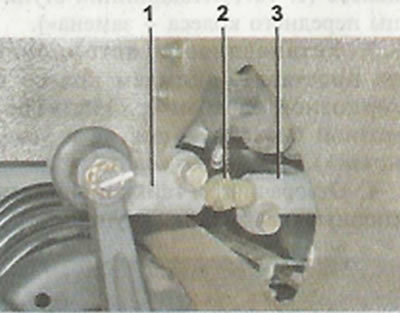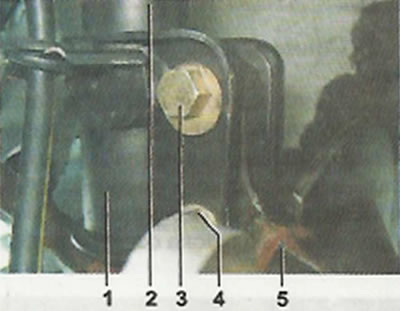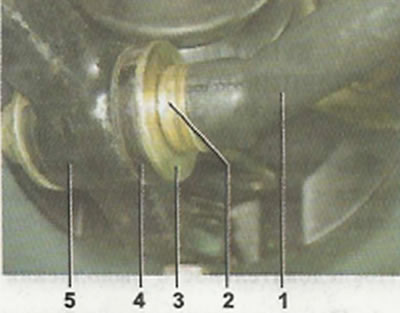
Front suspension: 1 - stabilizer bar; 2 - bracket for attaching the stabilizer bar; 3 - transverse arm bracket; 4 - transverse lever; 5 - stabilizer bar; 6 - telescopic stand; 7 - ball bearing; 8 - rotary fist; 9 - longitudinal stretching; 10 - extension bracket.

Connecting the front strut to the tie rod: 1 - tie rod end; 2 - threaded insert; 3 - steering rod.

Mounting the steering knuckle to the rack: 1 - bracket for mounting the steering knuckle; 2 - rack body; 3 - bolt (eccentric) top mounting of the steering knuckle; 4 - a bolt of the lower fastening of a rotary fist; 5 - steering knuckle.

Longitudinal brace attachment to transverse arm: 1 - rear end of the longitudinal extension; 2 - adjusting washers; 3 - thrust washer; 4 - rubber-metal hinge; 5 - transverse suspension arm.
The front suspension is independent, with telescopic swivel struts, wishbones, trailing arm extensions and a torsion-type anti-roll bar.
The suspension strut consists of a housing in which a hydraulic telescopic shock absorber of a helical spring and an upper support are installed. Outside, a bracket for attaching the steering knuckle, a swing arm and a lower spring support cup are welded to the strut body.
The spring with its lower coil rests against the lower support cup, and with its upper coil rests against the upper support fixed on the shock absorber rod. Also installed on the shock absorber rod: a compression stroke buffer with a protective cover, a rubber gasket with a cup and an upper support bearing. The support body is attached to the car body with three studs and nuts. The bearing allows the shock absorber rod to rotate in the support when the strut is turned, and the rubber gasket prevents the transmission of vibrations to the car body.
The shock absorber rod is protected from dirt and dust by a plastic casing. In the event of a breakdown of the suspension, the stroke of the rod is limited by the compression stroke buffer.
The strut pivot arm is connected to the tie rod via a ball pin. Changing the length of the rod using a threaded insert allows you to adjust the toe of the front wheels.
The steering knuckle is attached to the strut bracket with two bolts and nuts. The upper hole of the bracket is oval, and the bolt installed in it has an eccentric belt and an eccentric washer. When this bolt is rotated, the steering knuckle will be mixed relative to the rack, turning on the lower mounting bolt, as on an axle. This changes the angle between the strut and knuckle, which in turn allows you to adjust the camber of the front wheel.
A double-row ball bearing is pressed into the hole of the steering knuckle and fixed with two circlips. The wheel hub is pressed into the inner ring of the bearing.
From below, the steering knuckle is connected to the transverse suspension arm by means of a ball joint. The transverse lever is kept from moving by an extension, which, with its rear end, is attached through a rubber-metal hinge to the lever, and with its front end through a pillow to a bracket mounted on the car body. By changing the number of washers in the front and rear mounts of the brace, you can change the position of the lever, thereby adjusting the angle of the longitudinal inclination of the axis of rotation of the wheel.
The ends of the anti-roll bar are connected by struts to the wishbones of the front suspension of the car. The central part of the stabilizer is fixed through the rubber cushions on the body with brackets. The movement of one of the levers through the stabilizer is transmitted to the second. This allows you to partially synchronize the work of both sides of the suspension and thereby reduce the swaying of the car on rough roads and rolls in corners.
After repairing any suspension or steering components, be sure to check the alignment of the front wheels. It is possible to qualitatively check and adjust the angles of the front wheels only in the conditions of a service company that has a special stand for performing adjustment work.
